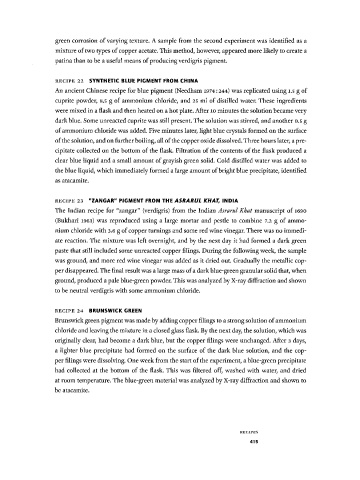Page 432 - Copper and Bronze in Art: Corrosion, Colorants, Getty Museum Conservation, By David Scott
P. 432
green corrosion of varying texture. A sample from the second experiment was identified as a
mixture of two types of copper acetate. This method, however, appeared more likely to create a
patina than to be a useful means of producing verdigris pigment.
RECIPE 22 SYNTHETIC BLUE PIGMENT FROM CHINA
An ancient Chinese recipe for blue pigment (Needham 1974:244) was replicated using 1.5 g of
cuprite powder, 8.5 g of ammonium chloride, and 25 ml of distilled water. These ingredients
were mixed in a flask and then heated on a hot plate. After 10 minutes the solution became very
dark blue. Some unreacted cuprite was still present. The solution was stirred, and another 0.5 g
of ammonium chloride was added. Five minutes later, light blue crystals formed on the surface
of the solution, and on further boiling, all of the copper oxide dissolved. Three hours later, a pre
cipitate collected on the bottom of the flask. Filtration of the contents of the flask produced a
clear blue liquid and a small amount of grayish green solid. Cold distilled water was added to
the blue liquid, which immediately formed a large amount of bright blue precipitate, identified
as atacamite.
RECIPE 23 "ZANGAR" PIGMENT FROM THE ASRARUL KHAT, INDIA
The Indian recipe for "zangar" (verdigris) from the Indian Asrarul Khat manuscript of 1690
(Bukhari 1963) was reproduced using a large mortar and pestle to combine 7.2 g of ammo
nium chloride with 3.6 g of copper turnings and some red wine vinegar. There was no immedi
ate reaction. The mixture was left overnight, and by the next day it had formed a dark green
paste that still included some unreacted copper filings. During the following week, the sample
was ground, and more red wine vinegar was added as it dried out. Gradually the metallic cop
per disappeared. The final result was a large mass of a dark blue-green granular solid that, when
ground, produced a pale blue-green powder. This was analyzed by X-ray diffraction and shown
to be neutral verdigris with some ammonium chloride.
RECIPE 24 BRUNSWICK GREEN
Brunswick green pigment was made by adding copper filings to a strong solution of ammonium
chloride and leaving the mixture in a closed glass flask. By the next day, the solution, which was
originally clear, had become a dark blue, but the copper filings were unchanged. After 3 days,
a lighter blue precipitate had formed on the surface of the dark blue solution, and the cop
per filings were dissolving. One week from the start of the experiment, a blue-green precipitate
had collected at the bottom of the flask. This was filtered off, washed with water, and dried
at room temperature. The blue-green material was analyzed by X-ray diffraction and shown to
be atacamite.
R E C I P E S
415

